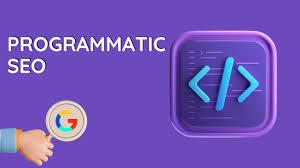Programmatic SEO has emerged as one of the most powerful methods to scale organic traffic efficiently, especially for websites with expansive datasets or structured content. By automating the creation of optimized web pages at scale, businesses are harnessing this approach to drive exponential traffic growth without the manual overhead typically associated with traditional SEO. In this guide, we’ll explore how to use programmatic SEO to scale organic traffic, why it works, and how to implement it in a way that ensures long-term success.
Understanding Programmatic SEO
At its core, programmatic SEO is the process of using templates, databases, and automation to generate hundreds or thousands of web pages targeting long-tail keywords. Unlike traditional SEO that focuses on handcrafting individual pages, programmatic SEO enables the creation of multiple pages dynamically, using structured content elements like location data, product attributes, or FAQs.
For example, a website like TripAdvisor doesn’t manually write a page for every “Best Hotels in [City]” combination. Instead, it uses programmatic systems to pull content from a database, organize it into a consistent template, and publish optimized pages that target specific search intents.
This method is ideal for websites that have extensive product catalogs, directories, or location-based services. It empowers marketers and developers to cover thousands of keyword variations at scale while keeping the content relevant and indexable.
Why Programmatic SEO Is Crucial for Scaling
The main advantage of programmatic SEO is scale. Traditional SEO efforts often involve time-intensive content creation, link building, and on-page optimization, which makes it hard to target the vast spectrum of long-tail queries that users search daily. Programmatic SEO addresses this limitation by allowing you to automatically generate content for each variation of a search query.
Search engines like Google are increasingly prioritizing relevance and search intent. With the rise of AI and better semantic understanding, targeting long-tail keywords with highly relevant pages can result in significant organic traffic. Programmatic SEO allows you to capture these keywords efficiently, enabling your website to become an authority in its niche.
It also complements the trend toward hyper-specific search behavior. As users type more conversational and intent-based queries, having content that directly addresses those terms improves both visibility and click-through rates.
How to Use Programmatic SEO in a Scalable Framework
To effectively implement programmatic SEO, the process must be approached with a clear structure and robust backend support. The key steps in creating a successful programmatic SEO strategy involve research, data collection, template creation, technical infrastructure, and ongoing optimization.
The first step is keyword research at scale. You need to identify a list of long-tail keyword variations that users are actively searching. This is where keyword tools like Ahrefs, SEMrush, and Google Keyword Planner become indispensable. Instead of focusing on single high-volume keywords, your goal should be to discover thousands of specific combinations like “Best vegan restaurants in [city name]” or “Affordable yoga classes in [neighborhood].”
Once you’ve identified your keywords, the next step is to build a structured database. This might include city names, product features, service categories, or user-generated data, depending on your niche. A clean and comprehensive dataset is essential because each data point feeds into your content templates.
Next comes template creation. Your development team or CMS must be able to generate pages dynamically using your database inputs. For example, if you’re creating a programmatic SEO strategy for a real estate website, your template might include fields for location, average home price, property listings, and local attractions. The goal is to provide value while ensuring each page has unique and useful content that meets Google’s quality standards.
Once your templates and database are aligned, focus on your URL structure and internal linking. Each page should have a clean, SEO-friendly URL and be properly interlinked with related content to help with indexing and authority distribution. Schema markup and structured data can further boost visibility in search results by enhancing snippets and making your pages more machine-readable.
A common mistake is to launch thousands of programmatic pages without considering content quality or indexability. Always make sure your pages include unique text, images, or user-generated content to avoid thin content penalties. Google’s Helpful Content Updates have raised the bar, and programmatic SEO must now deliver real value—not just keyword-stuffed templates.
Real-World Examples of Programmatic SEO in Action
Several brands have successfully scaled their SEO efforts using this method. Zapier, for instance, has built thousands of pages targeting “[App1] integrates with [App2]” using templates and a structured dataset. These pages rank well because they serve a genuine user need and are automatically kept up to date.
Another example is Indeed, the job search engine. It uses programmatic SEO to create millions of location- and job-title-specific pages, such as “Marketing Jobs in San Diego.” Each of these pages contains dynamic content from a central job database, optimizing for both relevance and freshness.
Even educational platforms use programmatic SEO. For instance, a digital marketing course website could generate location-based landing pages like “Online Digital Marketing Course in Mumbai,” each tailored with testimonials, course highlights, and city-specific career outcomes.
Challenges and Best Practices
Despite its scalability, programmatic SEO is not without challenges. One of the biggest risks is duplicate or thin content, especially if your templates are too generic. You also need to invest in robust server architecture and caching systems to handle the scale without compromising performance.
Search engines may also limit the number of pages they crawl from your site (crawl budget), especially if they suspect low-value content. To combat this, prioritize high-quality templates, use XML sitemaps wisely, and leverage tools like Google Search Console to monitor indexing and crawl behavior.
Don’t overlook user experience. While it’s tempting to focus on search engines, the real success of programmatic SEO lies in creating pages that users find helpful. Personalized content, updated data, and multimedia integration can significantly improve engagement metrics, which in turn support your rankings.
The Future of Programmatic SEO
As AI continues to transform how content is created and optimized, the principles of programmatic SEO are evolving. Tools like ChatGPT, Claude, and other language models can now assist in generating high-quality content blocks at scale, further reducing manual work. However, human oversight remains critical to ensure factual accuracy, tone consistency, and adherence to brand guidelines.
Additionally, with Google experimenting with AI Overviews and deeper semantic search, context and intent will matter more than ever. Future-proofing your programmatic pages means aligning them with user needs rather than simply matching keywords.
Incorporating advanced tools, real-time data feeds, and user feedback loops will be essential for keeping programmatic SEO strategies effective in the long run.
Conclusion
Learning how to use programmatic SEO to scale organic traffic can unlock tremendous growth potential for businesses of all sizes. When implemented thoughtfully, this approach enables you to dominate long-tail search terms, drive targeted visitors, and build topical authority across your niche. However, it requires a combination of SEO expertise, technical infrastructure, and content strategy to work effectively.
Whether you’re managing a marketplace, directory site, or digital marketing course platform, programmatic SEO offers an intelligent, scalable solution to modern organic growth challenges. By blending automation with user-centric design and SEO best practices, your business can turn data into discoverability—on a massive scale.












